
Personal regalia, in the form of colourful sashes and neck ribbons were an integral feature of friendly societies from the time of their formation and were used by many other mass membership groups. In the AOF as early as 1836 different colour combinations were implemented ‘for the purpose of giving uniformity throughout the Order, and for distinguishing the ranks of officers in a mixed assembly.’
What’s special about OUR collection of AOF personal regalia?
| > | Many of the items can be associated with a particular member, providing a personal and intimate link with the past; |
| > | Our regalia has the potential to enable definitive chronological and typological displays of AOF items to be established |
| > | Material in our Archive offers potential for original research to be conducted into neglected aspects of our sashes, neck ribbons and collars. |
Subject Headings Banners |
Further Reading Discovering Friendly and Fraternal Societies, Victoria Solt-Dennis (2005) The Ancient Order of Foresters Friendly Society - 150 Years, Walter Cooper (1984) |
 |
 |
 |
 |
 |
 |
 |
 |
 |
 |
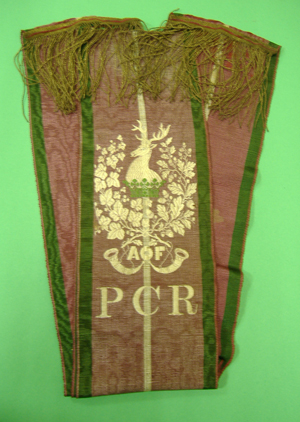 |
PCR Sash At the AOF Liverpool High Court Meeting (HCM) of August 1839, delegates confirmed the colour combinations for personal regalia. For past officers of a subordinate Court (branch), the colour purple was confirmed as the main element. At either side of the sash, as shown in this specimen, was a green stripe, to run the whole length of the sash. In the case of a Past Chief Ranger (Court chairman), an additional white stripe ran down the centre of the sash. This confirmed the colour combination in use since the establishment of the Ancient Order of Foresters in August 1834. The sash shown here is from a later period, although it is notoriously difficult to date such items. On it are depicted a stag’s head, with the initials AOF indicating Ancient Order of Foresters. PCR stands for Past Chief Ranger of a local Court. Chosen by his fellow members to serve in office for a period of 3, 6 or 12 months, a PCR was often presented with a sash as mark of recognition of services well provided. He would then have worn it with some pride at the anniversary parades of other social events. |
||
| Back to Top | |||
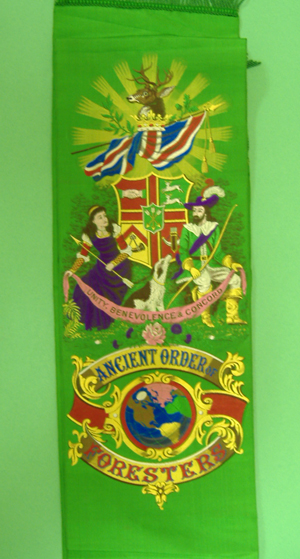 |
PCR Sash During the second half of the 19th century, purple as the principal colour on a Past Chief Ranger’s sash was replaced by the Foresters ‘natural’ colour, green. Following the HCM delegates decision at Ipswich in 1892 to admit female benefit members, the regalia was subsequently redesigned to reflect the changed situation. On this example, the supporters to the Order’s coat of arms are a male and a female Forester, enabling a post 1892 date to be assigned. A significant contest to these images of Forestry is given by the inclusion of the union flag and brightly coloured globe. Assigning a maker’s name to any particular sash is difficult. Often impossible. As yet no typology has been established to enable ready identification. Fortunately this sash bears on the back of the woven emblem the name of H C Slingsby, of Nuneaton, Warwickshire. It was Slingsby’s, who trading under slightly different names at different times, were the sole authorised suppliers of AOF regalia from the early 1860’s through to the 1890’s. According to a local newspaper report of 1865, when their first Registered Emblematical sash was introduced, ‘the loom in which it is woven is a masterpiece and a model piece of machinery. The mounting takes in two 900 Jacquard machines, and every inch of the superb badge requires 700 shoots.’ |
||
| Back to Top | |||
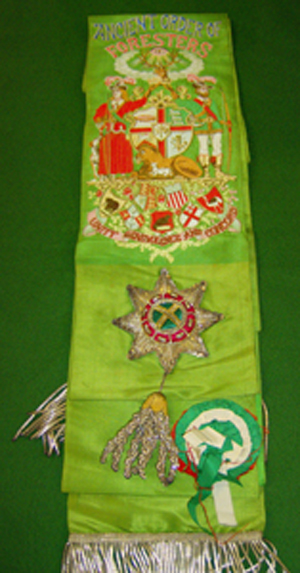 |
PCR Sash Known better for his banners, George Tutill was a supplier of all types of items associated with friendly societies. Included was personal regalia and it is clear that from an early date he manufactured sashes. Some were advertised in Foresters official publications such as the Foresters’ Miscellany, although not as specifically AOF regalia. As a Forester himself he would have been aware of successive Executive Councils’ attempts to persuade members to only buy authorised items through them. George Tutill died in 1887 but the firm continued in his name and in the early 1890’s Tutill’s began to supply the Foresters with Sashes. Proudly the statement ‘Manufacturer’s by appointment to the Executive Council (AOF)’ appeared in advertisements. There were specific examples of their work as in a ‘Sash, 3 yards, Tutill’s gold wire design, each 12s (60p).’ The example shown here, with the male and female Forester indicates that this is post 1892, and the decision to admit females. Designs were increasingly elaborate with some of the earlier features, such as the stag’s head, no longer appearing. |
||
| Back to Top | |||
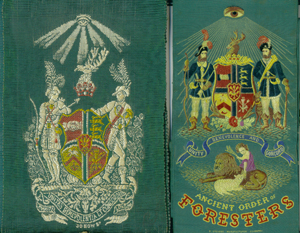 |
Unusual Sashes Whilst Slingsby’s attained the position of sole authorised supplier of AOF regalia from the 1860’;s to 90’s, and Tutill’s was also significant provider, there were smaller firms making sashes for friendly society members One example of these is shown on the left of this image. This was a product of the firm Robert White. Operating from Bow Street, London, in 1862 he was offering ‘sashes in any colour all at one price.’ Life was tough at this time, it appears, for the smaller manufacturer, White’s advertisement of the period acknowledging ‘best thanks to the brethren of benefit societies…which has enabled him successfully to break through the monopoly so long existing…’ The design on the sash brings a fresh perspective to the more regularly encountered designs. The other example shown is that of another provincial manufacturer, Thomas Stevens, of Coventry. Known today as the creator of ‘Stevengraphs’ this is a rarely seen style of Foresters’ sash, bearing the distinctive coat of arms flanked by Forester supporters. The added pictorial scene shows the lion and the lamb together representing the spirit of concord. |
||
| Back to Top | |||
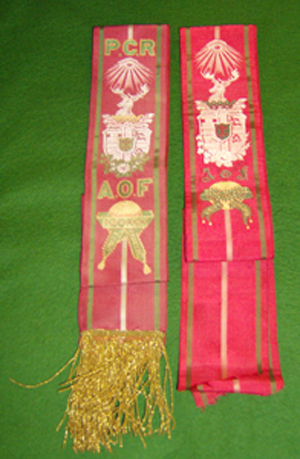 |
Neck Ribbons Neck Ribbons, along with sashes, formed the initial personal regalia in the Foresters from its beginnings in 1834. Little is known of the early design and form of Neck Ribbons. References in the Order’s Annual Accounts suggest that, apart from the approved colours with distinctive lining down the edges, there were no designs or illustrative scenes, Ribbons simply being cut to the appropriate lengths from continuous rolls. In 1862 the firm of H Slingsby started to supply the AOF with Registered Emblematical Ribbons. Announcing it the Portsmouth EC said that ‘the Ribbon, which retains its authorised colour and form, is much improved in its quality, and the appearance of each Ribbon is considerably enhanced by the Emblems and motto of the Order being beautifully woven therein, thus forming a handsome badge or collar in harmony with the regulations for personal regalia, and more in accordance with good taste than the usual appendages of stars, rosettes, etc.’ The price of each one and a half yards (137cm) long Ribbon, with Device, was 2 shillings (10p). |
||
| Back to Top | |||
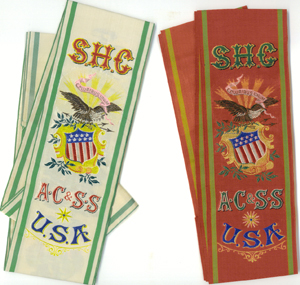 |
Neck Ribbons - USA As Forestry spread across the English speaking world, so too did the regalia made in England. The Order Accounts refer to items being sent out to overseas Districts and Courts which were the same as used in the UK. Arising from the suspension and subsequent expulsion of the 383 Courts formerly under the jurisdiction of the Subsidiary High Court of the USA, established in 1874, and the latter’s Dispensation being withdrawn, two new Subsidiary High Courts were authorised for operation in the USA. These were the SHC of the Pacific Coast (1889), and the SHC of the Atlantic, Central and Southern States (1891). Both continued to be active throughout the 20th century. Unusually the ACSS SHC had its own personal regalia, examples of which are illustrated here. The purple Neck Ribbon maintains the traditional colouring but bears a distinctive Device. This is also included on the plain white collar. The maker was either Slingsby or Tutill. |
||
| Back to Top | |||
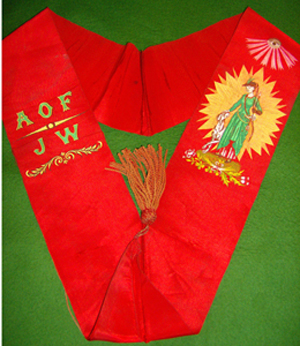 |
Female Collar The introduction in the AOF of specifically designed female collars, in the post 1892 situation, came about in a surprisingly low key. The EC, in their July 1894 Report, briefly were able to ‘call attention to the female regalia now in stock.’ An entry in the January to April 1894 quarterly accounts showed that ‘69 Emblematical Collars for Females’ had been purchased from G. Tutill, at a total cost of £17 5s (£17.25), indicating a unit purchase price of 5s (25p) each. The small number purchased from the manufacturer suggests that the EC was still uncertain about the ‘new departure’ as it was termed, of admitting females as benefit members. No price list indicating the selling price of collars was published until April 1895 when this was shown to be 5s 6d (27.5p) each. Available in red or green, female collars were three and a half inches (9cms) wide, and the design broke entirely with tradition by showing a single female figure with her dog under the all-seeing eye but without the Order coat of arms appearing. Those worn by female Court officers either had the standard initials woven in, as shown in the illustration, or had appropriate individual metal letters attached. |
||
| Back to Top | |||
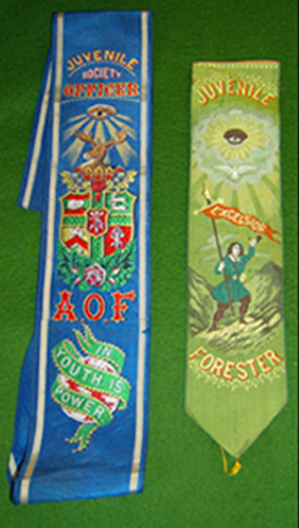 |
Juvenile Collars A modest departure from the policy of supplying Sashes and Ribbons came in 1874 when an Emblematical Ribbon was introduced for juvenile members. The Executive Council have much pleasure in announcing that they have introduced into their saleable stock a Registered Ribbon to be worn by the Members of Juvenile Societies. The Ribbon is of a brilliant light green two and a half inches (6cms) wide, and one and a quarter yards (114cms) long, with an Emblematical Design seven and a half inches (19cms) long, representing the figure of a Juvenile Forester, on appropriate background, bearing aloft a streamer with the Motto ‘Excelsior,’ surmounted by a Dove and the ‘All-seeing Eye,’ from which radiations of light proceed. The words Juvenile Forester are also interwoven in gold and scarlet lettering, the whole forming a most appropriate Design. The selling price for the Ribbon, manufactured by Slingsby, was given as 1s 9d (8p), with an indication that the Ribbon could be made into a Collar for just 1d (0.5p) more. Juvenile Societies were by this time being actively encouraged, although the first such appears to have been formed as far back as 1840 at Hull. As well as being useful for the benefits provided to juveniles they were considered to be a valuable source of future adult members. |
||
| Back to Top | |||
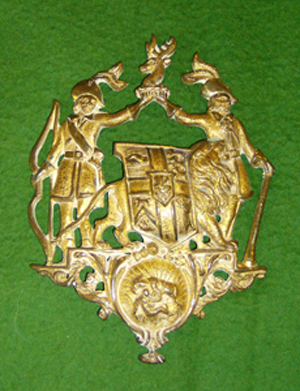 |
Sash Clasp or Tie The nature of both the sash and ribbon, as worn by AOF members, required them to be tied together is some way for convenience in wearing them. By the 1860’s, possibly earlier, regalia manufacturers had created clasps or ties specifically for the purpose. In 1862 George Tutill was advertising ‘GOLD AND SILVER SASH TIES 1s (5p) and 1s 6d (7p) each – novel and much admired.’ Fellow manufacturer Robert White offered ‘Silver Sash Ties 1s 3d (6p) each, Gold and Silver mixed 1s 9d (8p) each.’ At a later date clasps and ties became more intricate in design with Tutill’s introducing registered sash ties, with silver plated or Gilt tops, in the form of a beehive, stag, crown or Britain. The example illustrated bears the name of G Tutill and is of a style encountered in both silver and gold. These items can be surprisingly heavy, and have been the cause of some damage to a sash. |
||
| Back to Top | |||
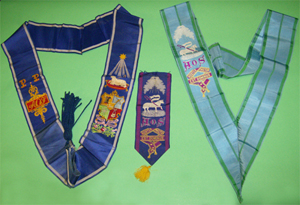 |
Shepherds Regalia The Ancient Order of Shepherds functioned as the second degree of Forestry from 1834 until c1889. The Shepherds originally comprised members of a Foresters’ Court having the inclination, and capacity, to pay for a second sickness benefit, in addition to that from the parent Court. By definition therefore these were members who were financially able to lay out a little more each week. Until the 1880’s, members of successive Foresters’ Executive Councils undertook the duties of the Shepherds’ Executive Council, and were required to be members of both Orders. The Ancient Order of Shepherds (which should not be confused with the Loyal Order of Ancient Shepherds, whose two Unities, the Ashton and Wisbech, were entirely separate Orders) had a High Sanctuary Meeting, equivalent to the Foresters’ High Court Meeting. Members at local level met in Sanctuaries which had the same names and number as the parent Foresters’ Court. The principal Sanctuary officer was a Pastor and the Secretary, a Scribe. Little primary source information about the AOS regalia exists, but fortunately some ribbons, collars and, rarely, sashes have survived to give a clues as to their design. Three of those in The Foresters Heritage Trust collection are shown here. |
||
| Back to Top | |||